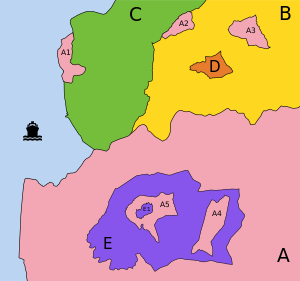
Back الحبيسة والمستحاطة Arabic Enclave y exclave AST Engklabo asin eksklabo BCL ছিটমহল ও এক্সক্লেভ Bengali/Bangla Clofan ac allglofan Welsh Enklave og eksklave Danish Περίκλειστο και αποσπασμένο έδαφος Greek Enclave y exclave Spanish درونبوم و برونبوم Persian Enclave et exclave French
- A:
- possesses 5 exclaves (A1, A2, A3, A4, and A5): it is impossible to go from the main part of A to any of these parts going only through territory of A; however:
- A1 and A2 are not enclaves: neither of them is surrounded by a single "foreign" territory;
- A1 is a semi-enclave and a semi-exclave: it has an unsurrounded sea border;
- A2 is an exclave of A: it is separated from A;
- A3 is an enclave: it is totally surrounded by B;
- A4 and A5 are counter-enclaves (also known as second-order enclaves): territories belonging to A that are encroached inside the enclave E;
- contains 1 enclave (E): "foreign" territory totally surrounded by territory of A;
- contains 1 counter-counter-enclave, or third-order enclave (E1).
- possesses 5 exclaves (A1, A2, A3, A4, and A5): it is impossible to go from the main part of A to any of these parts going only through territory of A; however:
- B:
- contains 2 enclaves (A3 and D).
- C:
- continuous territory, contains no enclave or exclave
- D:
- is an enclaved territory: it is territorially continuous, but its territory is totally surrounded by a single "foreign" territory (B).
- E:
- is an enclaved territory: it is inside A;
- contains 2 enclaves (A4 and A5), which are counter-enclaves of A;
- possesses 1 counter-enclave (E1), which is a counter-counter-enclave as viewed by A and contained within A5.
An enclave is a territory that is entirely surrounded by the territory of only one other state or entity. An enclave can be an independent territory or part of a larger one.[1] Enclaves may also exist within territorial waters.[2]: 60 Enclave is sometimes used improperly to denote a territory that is only partly surrounded by another state.[1] Enclaves that are not part of a larger territory are not exclaves, for example Vatican City and San Marino (both enclaved by Italy) and Lesotho (enclaved by South Africa) are enclaved sovereign states.
An exclave is a portion of a state or district geographically separated from the main part, by some surrounding alien territory.[3] Many exclaves are also enclaves, but an exclave surrounded by the territory of more than one state is not an enclave.[4] The Azerbaijani exclave of Nakhchivan is an example of an exclave that is not an enclave, as it borders Armenia, Turkey and Iran.
Semi-enclaves and semi-exclaves are areas that, except for possessing an unsurrounded sea border (a coastline contiguous with international waters), would otherwise be enclaves or exclaves.[4]: 116 [5]: 12–14 Semi-enclaves and enclaves are mutually exclusive. Likewise, semi-exclaves and exclaves are mutually exclusive. Enclaves and semi-enclaves can exist as independent states (Monaco, The Gambia and Brunei are semi-enclaves), while exclaves and semi-exclaves proper always constitute just a part of a sovereign state (like the Kaliningrad Oblast).[4]
A pene-exclave is a part of the territory of one country that can be conveniently approached – in particular, by wheeled traffic – only through the territory of another country.[6]: 283 Pene-exclaves are also called functional exclaves or practical exclaves.[5]: 31 Many pene-exclaves partially border their own territorial waters (i.e., they are not surrounded by other nations' territorial waters), such as Point Roberts, Washington, and Minnesota's Northwest Angle. A pene-exclave can also exist entirely on land, such as when intervening mountains render a territory inaccessible from other parts of a country except through alien territory. A commonly cited example is the Kleinwalsertal, a valley part of Vorarlberg, Austria, that is accessible only from Germany to the north.
- ^ a b Raton, Pierre (1958). "Les enclaves". Annuaire Français de Droit International. 4: 186. doi:10.3406/afdi.1958.1373.
- ^ Cite error: The named reference
Melamidwas invoked but never defined (see the help page). - ^ "Exclave". Webster's Encyclopedic Unabridged Dictionary of the English Language. 1989. p. 497.
- ^ a b c Rozhkov-Yuryevsky, Yuri (2013). "The concepts of enclave and exclave and their use in the political and geographical characteristic of the Kaliningrad region". Baltic Region. 2 (2): 113–123. doi:10.5922/2079-8555-2013-2-11.
- ^ a b Cite error: The named reference
EVwas invoked but never defined (see the help page). - ^ Robinson, G. W. S. (September 1959). "Exclaves". Annals of the Association of American Geographers. 49 (3, [Part 1]): 283–295. doi:10.1111/j.1467-8306.1959.tb01614.x. JSTOR 2561461.
